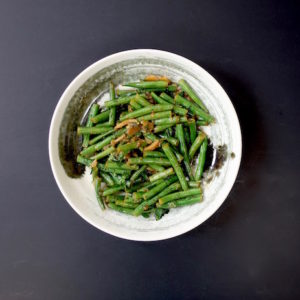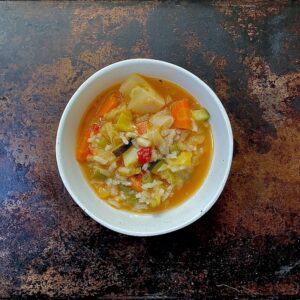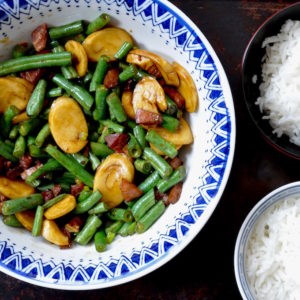Black Beans and Rice
Don’t throw out the soaking water with all the minerals and flavor. Instead, throw out the book that tells you to do so.
Melissa Hamilton and Christopher Hirsheimer, quoting Diana Kennedy, in Canal House Cooks
The more you know about rice and beans, the more the dish inspires you as a cook and delights you as an eater.
John Thorne, Serious Pig
Few kitchen chores are simpler than cooking beans.
Mark Bittman, How to Cook Everything Vegetarian
After you been having/Steak for a long time/Beans, beans taste fine
Shel Silverstein, “Beans Taste Fine”
Beans are a food of impassioned opinion. Why this is so I cannot say. But few foods elicit such a strong response where preparation is concerned. To soak or not? If yes, for how long? Is tap water suitable? Come cooking time, should the soaking water be discarded or used to cook the beans?

Once the beans make it into the pot–and we’ll get to that pot–discussion turns to what seasonings should accompany the beans, and when best to add them. Discussions about when to add salt is a lively topic, with prevailing wisdom to wait until the beans are nearly done, advice breaking every rule cooks otherwise learn about salting food. What better way to unnerve the anxious beginner?

Every step of the bean cooking process leaves room for argument. And argue people do.
—
Sooner or later the question of digestion arises. Beans cause gas. Every bean-eating culture has a method of dealing with this: asoefetida, ginger, fennel. Most helpful is gradually adding beans to your diet, rather than consuming them at irregular intervals.

Lacking an appropriate photo, I give you hot sauce.
—
For years I thought myself a hopeless bean cook. Even as I learned to bake, pressure can, and confit, I remained incapable of producing an edible pot of beans. At infrequent intervals I’d try again, buying dried beans from the market, dutifully soaking them overnight, then simmering them all afternoon. By dinnertime some beans had collapsed into mush. Others remained rock-like. All were inedible. Discouraged, I returned to beans from cans (and jars).

—
It wasn’t until I bought a bag of fresh dried beans–I know how oxymoronic that sounds–that I realized where the trouble lay. Or the blame. And it wasn’t with me. After a comparatively brief three hour soak, I poured the beans into my cracked by serviceable Goodwill bean pot and added water to cover. An hour later–yes, one measly hour–I had a pot of perfectly cooked beans.

The first pot.
—
It sounds a misnomer to describe dried beans as fresh, or for that matter, stale. But legumes, pulses, pastas, and rice all eventually stale, just as “fresh” food does. The problem is dried foods, unlike their fresh counterparts, usually lack “best by” or “packed on” dates warning the cook they may be far past both.

The only way to avoid stale beans is to shop wisely. Buy your beans at markets with high turnover. Now is the time to visit health food stores and fancy food shops carrying better brands. Look for beans that offer “sell-by” or “packed on” dates. As for expense, even the most pedigreed bean remains inexpensive.

Fresh borlotti beans, bought a few months ago. Cheaply.
—
In describing black beans, people often invoke the adjective “meaty.” It’s not a bad description. At a time when we’re being told to consume less meat for reasons of health–planetary and personal–I for one welcome black beans and rice into my kitchen. Not that they weren’t here before, but the canned black bean, while serviceable, just doesn’t compare to the dried. Neither canned nor dried replace animal protein; they don’t have to. Black beans–with rice or without–are enough in themselves. Which is why people have been eating them for millenia, and why I was so embarrassed about my inability to cook them.

—
A quick note about bean pots. A person can spend hundreds of dollars on a pot designed to cook a food costing less than $5 a pound. Happily, there are ways around this, and you should take them.

I have four bean pots. None cost more than $10. All were bought secondhand. I heartily recommend this method of bean pot acquisition. Search your local Goodwill, thrift shop, or garage sale. If you live near an old-fashioned hardware store, the kind with an extensive kitchenware section, look there, too. Such places once carried bean pots as a matter of course, and didn’t charge the moon for them.

A final note. At the risk of sounding a bit too Northern California for my own good, beans and rice is one of thoses dish that can turn into lifelong quest. It is a dish of endless national and ethnic variations. You can prepare it every day of the year and never make it the same way twice. So please consider the recipe below as one way, but hardly a definitive way. Interested readers are directed to John Thorne’s incisive writing about rice and beans: see Serious Pig and Outlaw Cook. Thorne abruptly fell off the face of the earth some years ago; his devoted fans miss him terribly. Read his books and join the club.

Black beans and Rice
yield: serves 2-4 people; easily scaled up or downward
prep time: see discussion of bean soaking below. Hands-on prep, about 30 minutes, then 1-2.5 hours cooking time, depending on age of beans and whether you add a ham hock.
Before starting the recipe, be sure your beans are fresh. If your beans have been sitting in the cupboard for months or longer, please toss them and buy a fresh bag. If possible, buy beans that have a sell-by date or give a “packed on” date. Barring these, buy your beans at a store with a lot of turnover.
3/4 cup/6 ounces/180 grams black beans
olive oil, for the pot
1 carrot, scraped and cut into coins
1 shallot, peeled and chopped
1 stick celery, chopped
1 garlic clove, peeled and minced
bay leaf
parsley
ham hock (optional)
salt and pepper
3/4 cup/6 ounces/180 grams Basmati rice
optional extras:
your favorite hot sauce
sliced onion
sliced avocado
lemon or lime wedges
sour cream
tortillas
Soaking the beans:
I buy Rancho Gordo beans, and soak them for 3-4 hours in regular tap water. If you have a bean soaking method that works for you, by all means use it. This is what works for me.
I rinse the beans in a colander and cook them in fresh tapwater. Again, I know people have strong opinions about this. Do what works best for you. They’re beans, okay? This is not the UN.
If you don’t have a bean pot, use a heavy pot with a lid. Lacking a lid, use tinfoil. A clay or ceramic pot is ideal, but use what you have. Add just enough olive oil to cover the bottom of the pot. Add the carrot, shallot, celery, garlic, bay leaf, and parsley. Turn the heat to low and simmer the aromatics gently for a few minutes. Add the beans and just enough water to just cover–don’t swamp the beans.
If you are adding the ham hock, put it atop the beans.
Bring the beans to a gentle boil, stir as best you can, given the ham hock, then turn the heat down to simmer. Skim off any foam that rises, then put the lid on. Given my stove, I need to tinker with the heat level to ensure it simmers rather than boils. If you have the same issue, consider buying a flame tamer. They’re inexpensive and easily found at hardware stores.
Cooking time depends on the age of the beans. Mine beans are ready in an hour, but yours may need more time.
Once the beans are soft, you can add salt.
The ham hock, if you’re using it, may take longer to cook. Just keep the heat at a medium low simmer. Once the ham hock is soft, remove it to a dish and let it cool. When you are able to handle it, tear the meat from it in fork-size pieces. Put these back in the bean pot. As cook, you get to sample the hock to ensure it tastes right.
If you’re having rice with your beans, now is the time to make it. Get your rice pot out, or turn on your rice cooker.
You can serve black beans and rice separately, or spoon the beans over the rice.
Black beans and rice keeps, refrigerated, up to five days. Black beans may be frozen up to three months. Rice may be frozen up to two months. It is not a good keeper. If you aren’t freezing it, eat it within four days.
Serve black beans and rice with sliced avocado, onion, tomatoes, lettuce, tortillas, hot sauce, and sour cream. Black beans and rice dish is a classic dish with countless variations. This recipe is but one.





